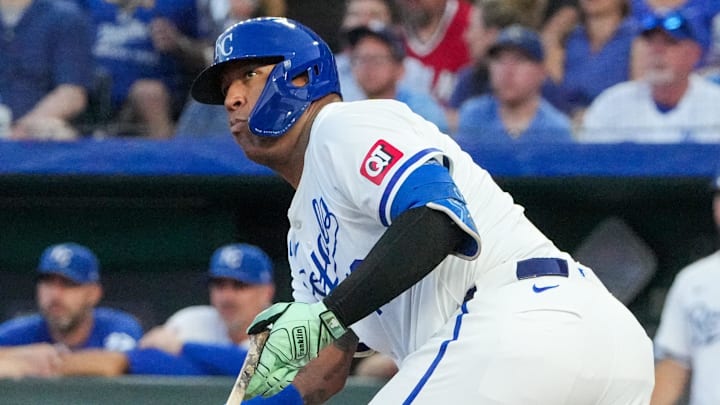Salvador Pérez Has Successfully Bridged the Gap Between Royals Eras

The Kansas City Royals had been thinking about making the move for a while, so when general manager J.J. Picollo approached catcher Salvador Pèrez and asked him to consider playing more first base, the executive was ready with his argument: You’ll get a bit of a break, which will allow you to focus on your offense and burnish your Hall of Fame case.
Pérez scoffed. I just care about winning, he said.
O.K., Picollo said. It’ll help us win.
That was all it took. Pérez, a nine-time All-Star, five-time Gold Glover and four-time Silver Slugger at catcher, has spent a third of his time at first this season. (Even on those days, he does not entirely relinquish his role; he sits in meetings with backup Freddy Fermín and still makes mound visits from first base.) The result? At 34, Pérez has put together one of the best seasons of his career and helped key the Royals to a likely playoff berth, their first in a decade. The people around him are talking about enshrinement in Cooperstown. Pérez thinks about that honor—“I think any player [wants that],” he says—but right now, he is focused on one thing.
“What I want so bad is for these guys to make it to the playoffs, because I know when you make it to the playoffs, and you feel that energy, that crowd—next year they’re just gonna want that again,” he says. “Let’s f------ go. Let’s go again. I didn’t know until 2014 how that feels. But after that …”
He smiles. He knows how it feels. And he wants to feel it again.
After the Royals made the playoffs in 2014 for the first time in 29 years, and won the World Series in ’15 for the first time in 30, Pérez thought he might be part of a budding dynasty. But they won 81 games in ’16 and 80 in ’17. And then … “I’m not saying anything [bad],” he says. “It’s just reality. You can go and [look it up].” Kansas City flirted with 100 losses in four of the next five full seasons.
By midway through 2023, en route to 106 defeats and a seventh straight losing season, Pérez had had about enough. The Royals had signed him for $65,000 when he was a 16-year-old in Venezuela. He had spent nine years with one manager, nine with one catching instructor, 13 with one GM. He had signed a five-year, $7 million deal with two club options—then played so well that the team ripped it up and gave him another $41 million. Manager Matt Quatraro says fans often tell him they owe their children to Pérez, whose 12th-inning walk-off single in the 2014 American League wild-card game gave the team its first playoff victory in a generation and enamored couples a reason to celebrate. (“It makes me feel a little weird,” Quatraro says with a laugh. “But it’s fun.”) Pérez had often spoken of wanting to spend his whole career in Kansas City, of earning a statue at Kauffman Stadium. The team had named him captain earlier that year.
But he also wanted to win again, and in his 30s, at 6’3”, 255 pounds, he knew he might not have forever. So a few days before the trade deadline, after months of consideration, and several emotional conversations with his mother, Yilda Díaz, and his wife, Maria Gabriela, he asked Picollo for a meeting.
Pérez asked Picollo and assistant general manager René Francisco—the international director who had signed him all those years earlier, now an assistant general manager—how far away from contention they believed the team to be. They admitted that they could not be sure. So, Pérez says, asked them to listen to trade offers for him.
“It was a really, really hard conversation,” says Pérez. “But J.J. understood. He’s a great human being. He said, ‘Salvy, I feel the same way.’”
Kansas City pursued talks with the Miami Marlins, the San Diego Padres and the Texas Rangers but could not reach an agreement. Pérez tamped down his disappointment and continued to show up for work in a good mood. Most people around the Royals did not even realize what had happened.
“It was really nice to see that, with as many games we lost last year, he’s the same guy all year,” says Quatraro. “And last year wasn’t the first year that had been a rough win-loss year, and so he’s endured a lot, but he understands his responsibility in [the clubhouse], and he also understands responsibility and community and what he means to the city.”
He adds, “Truthfully, in the offseason, my focus was: You see pictures of Salvy all over the facility, and there’s always a huge smile on his face, right? Let’s get him back to that.”
Pérez insists he would have waived his right to block a trade. Picollo and Francisco aren’t so sure. But it never got that far. Prez says, “Nothing happened for a reason.”
VERDUCCI: After a 106-Loss Season, What's Behind the Royals' Remarkable Turnaround?
That reason, he has decided, is so he can help Kansas City’s young players learn what his older teammates taught him, starting with the importance of taking the field every day. Every so often, Quatraro gives him a day off. By about the fourth inning, the skipper tends to notice a hulking presence in his peripheral vision, lobbying to pinch hit. “My body doesn’t feel great at this time of year and I’m only 24,” says star shortstop Bobby Witt Jr. “I can’t imagine how his feels, and he’s out there grinding it out.”
Pérez also reminds them of the importance of the mental game. He has noticed over the years that young players tend to look too far ahead. He tries to pull them back.
“Stay focused,” Pérez says. “‘We’re gonna play Cleveland in two weeks.’ Who cares about two weeks? You know how hard this game is? You can’t think about two weeks! Who cares about f------ Cleveland right now? Concentrate on today!”
And he always seems to know when it’s time for a pep talk.
“I’ve never been around a player like that,” says third baseman Paul DeJong, an eight-year veteran of five different organizations. “The ‘C’ on his chest is absolutely well deserved. He cares about the team. He’s got a positive attitude, and he says things to rally the troops, especially after we lost seven straight. ‘Keep the faith. We’re here for a reason.’ After a close [loss], we’re all kind of quiet, at our lockers, and he’ll say something like, ‘Hey, we got this. It’s fine.’ When you see a guy like that say that, it makes you feel better.”
“He might be lying a little bit,” Picollo allows, “but that’s part of [leadership] too.”
Another part of leadership is sharing it. After Kansas City signed Witt to a $289 million, 11-year deal in February, Picollo wondered how the team—and specifically the franchise catcher—would receive the news that a kid who couldn’t rent a car had just inked the 16th-richest contract in the history of the sport. So Picollo called Pérez.
“He was so happy,” says Picollo.
Partway through last season, Pérez had begun ceding his customary position as post-win emcee to Witt. “That was his way of showing the team, This is the guy,” Picollo says. “I’m still here, but this is the guy.”
Pérez’s reasoning is simple: He believes Witt is not the future but the present (a belief Witt has reinforced by becoming the first shortstop in MLB history with multiple 30-30 seasons). “I’ve never seen a young guy prepare himself like that,” Pérez says.
Perhaps inspired a bit by his eager teammate, Pérez has also redoubled his efforts this year to improve his defense. Early in his career, he was considered a stud behind the plate, but as the evaluation of catcher defense changed, Pérez did not.
When Quatraro left the Tampa Bay Rays to manage the Royals after the 2022 season, he brought along Paul Hoover to be his bench coach and catching instructor. Pérez had spent his entire career with one of the most old-school organizations in the game; Quatraro and Hoover were arriving from one of the newest.
“It took us a little while,” Hoover says with a laugh. “Probably not till toward the end of the season last year until we finally started getting really on the same page.”
When they first met, Pérez acknowledged that his receiving numbers did not match his peers’. “For a superstar like that to be able to say, ‘How can you help me?’ speaks to who he is, his work ethic and how he got to where he's at,“ Hoover says. So they began working on Pérez’s framing, helping him steal strikes on borderline pitches.
“I told him the first time we met, ‘You’re going to be a Hall of Fame catcher, not an umpire,’” Hoover says. “‘I see a lot of pitches that you assume are balls and strikes, so you don’t do your job. You just get it and throw it back, assuming he’s going to do his job. I want you to give yourself an opportunity to get these pitches. And so [we worked on] that philosophy of presenting the pitch, making everything look good; do your job, let him do his job; put as much pressure as you can by making it look as good as you can.”
From 2021 through ’23, according to Statcast, he cost his team an average of 10 runs per season on defense. This year, he has contributed one.
Despite all this, he remains a borderline Hall of Famer, in part because he sustained injuries that cost him parts of six seasons. Wins above replacement, the ubiquitous catch-all statistic, has been less impressed by his bat than the major league coaches and managers who select Silver Slugger winners. He ranks 31st in career WAR among catchers with 35.9, ahead of three Hall of Famers but behind 10 eligible catchers who did not make it.
“Five-time Gold Glover, World Series MVP, he’s going to end up having 300 home runs as a catcher, nine All-Star Games, leadership, face of the franchise, played his whole career for one team,” says Picollo. “I know I’m a little bit biased, but he’s a Hall of Famer. I know a lot’s been made about how his career WAR doesn’t match up with others’, but when you look at his whole body of work and what he’s done—and one thing that’s a little bit underappreciated is he’s done all that rarely at 100% [physically]. I don’t know how you put a value on that, but living with it every day, I know he’s a Hall of Famer.”
Pérez just shrugs. He will worry about a plaque at Cooperstown later. First he wants to ride in another parade down Grand Boulevard.
